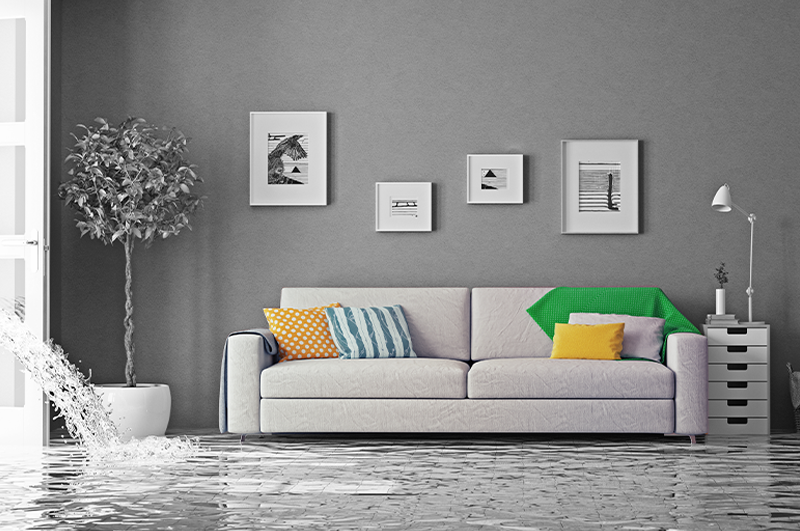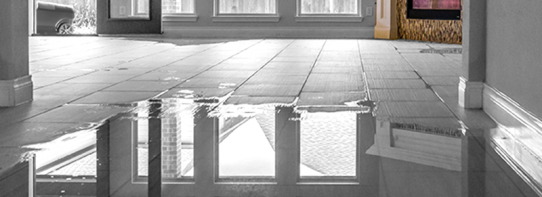Preparing for and Protecting Your Home from Floods

A flood can change your life in an instant. It can threaten your home, your financial security, and even the lives of those you love. While you can’t change the weather, you can do your best to prepare for the worst and potentially minimize the damage. Here are some tips to help you do it.
Your Home
- If you have a sump pump, choose one with back-up power and make sure it is well maintained.
- Hire a licensed electrician to ensure switches, sockets, circuit breakers, and all electrical wiring is installed at least 12 inches above the projected flood elevation of your home.
- Install backflow valves or plugs in drains, toilets, and other sewer connections.
- If you have any fuel tanks, make sure they are anchored to avoid potential damage, contaminating your or neighboring homes.
- Use masonry blocks or pressure-treated lumber to elevate your washer and dryer if they are in the basement or other area vulnerable to flooding.
- Elevate your furnace and water heater on masonry blocks at least 12 inches above your home’s projected flood elevation.
- Regularly clean your downspouts and gutters to remove leaves and other debris to prevent back up. Check street drains as well.
- Extend downspouts to keep water away from your home’s foundation.
- Add rain barrels to the bottom of your downspouts to collect and eventually redirect rainwater.
- Install window wells or windows with waterproof glass.
- Repair any cracks or leaks in your home’s foundation.
- Grade landscaping away from your home and use mulch.
- Plant trees and indigenous plants to reduce runoff.
- Incorporate drainage near paved driveways.
- Use water sensors or flood detection systems.
- Seal doors, windows, and any other openings like utility and exhaust connections.
- Keep sandbags on hand.
Your Family
- Know the risk of flooding where you live. You can find this information from your local planning and/or zoning office, county or local emergency management office, or local chapter of the Red Cross.
- Create an evacuation plan that includes a meeting place to reunite with your loved ones and a non-local contact person.
- Build an emergency supply kit with items you would need if you were unable to be in your home for 3 days.
There are some additional measures to take during and after a flood to keep your family safe. If waters are rising in your home before you are able to evacuate, move to an upper level, attic, or roof. Shut off water and electricity, but leave natural gas service on, unless local officials direct you otherwise.
After a flood, it is important to keep power off in your home until you can have it inspected by a professional. Check for gas leaks, electrical damage, and sewage.
Your Belongings
- Take pictures or videos of your valuables. This will help if you have to file insurance claims.
- Store important documents and sentimental personal items in a place that is least likely to be damaged by a flood. If that’s not possible, know where they are so you can quickly move them if threatened by flooding.
- Secure outdoor furniture, trash cans, and grills, or bring them inside in the event of inclement weather.
Flood Insurance
Even if you are not in a flood zone it is a good idea to get flood insurance. Your homeowner’s insurance does not cover damage caused by flood, and unless you have a separate flood insurance policy, you will be responsible for the cost to fix or replace any loss or damage that you suffer. In high-risk areas, lenders will often require buyers to have flood insurance. Low-risk areas it may not be required but flash floods have been on the rise and effect all areas.
For some of the higher risk properties, flood insurance must be purchased through the National Flood Insurance Program (NFIP), which is supported by the U.S. Federal Emergency Management Agency (FEMA). Over the last decade there have been a number of private insurance markets that have come into play for those who qualify. These private carriers are able that offer enhanced coverage and competitive pricing over a normal FEMA written policy.
Floods are the nation’s most common and costly natural disaster that cause millions of dollars in damage every year. According to FEMA, for many low-risk households, a flood insurance policy can cost less than $400 per year. When considering a single inch of water in your home can cause upwards of $25,000 worth of water damage, that $400 can provide invaluable peace of mind.
It is never too early to prepare to protect your home from the threat of floods. And because weather is unpredictable, you don’t want to wait to insure your home. In fact, unless you are closing on a loan, there is usually a 30-day waiting period after your application has been submitted before coverage takes effect.
The insurance experts at Hanson & Ryan can help you protect your home with flood insurance. We have been in business for over 140 years, gaining a complete, comprehensive understanding of not only the importance of flood insurance but the coverage offerings, and the process of purchasing flood insurance. If you would like to discuss your flood insurance options, please contact us.




